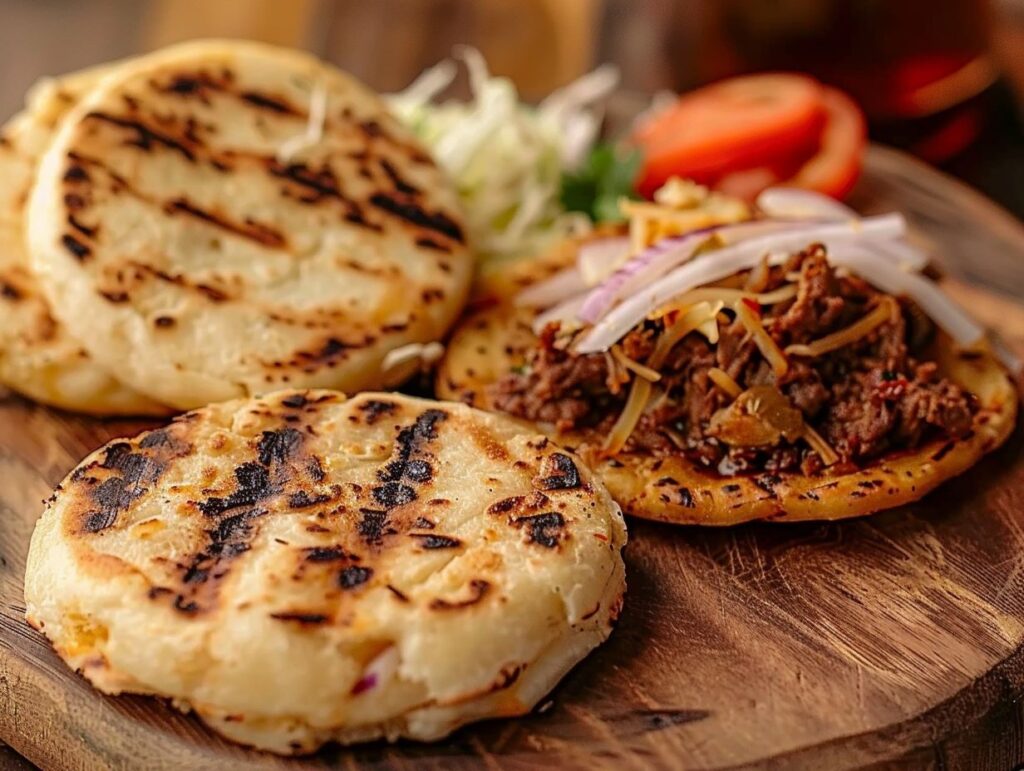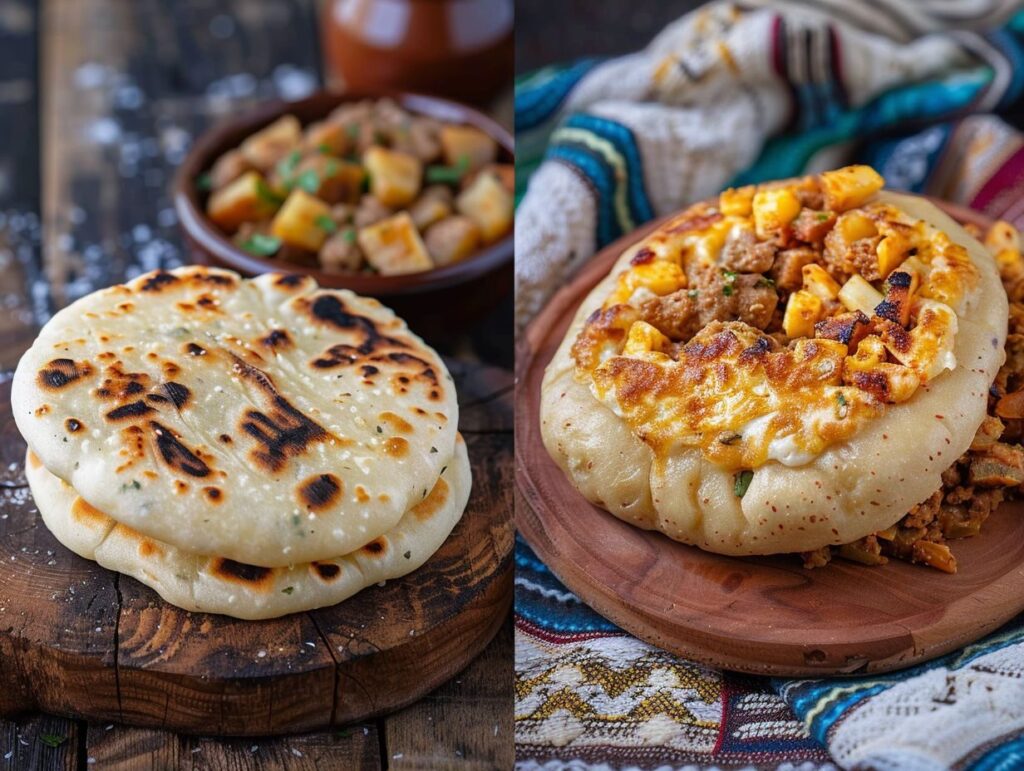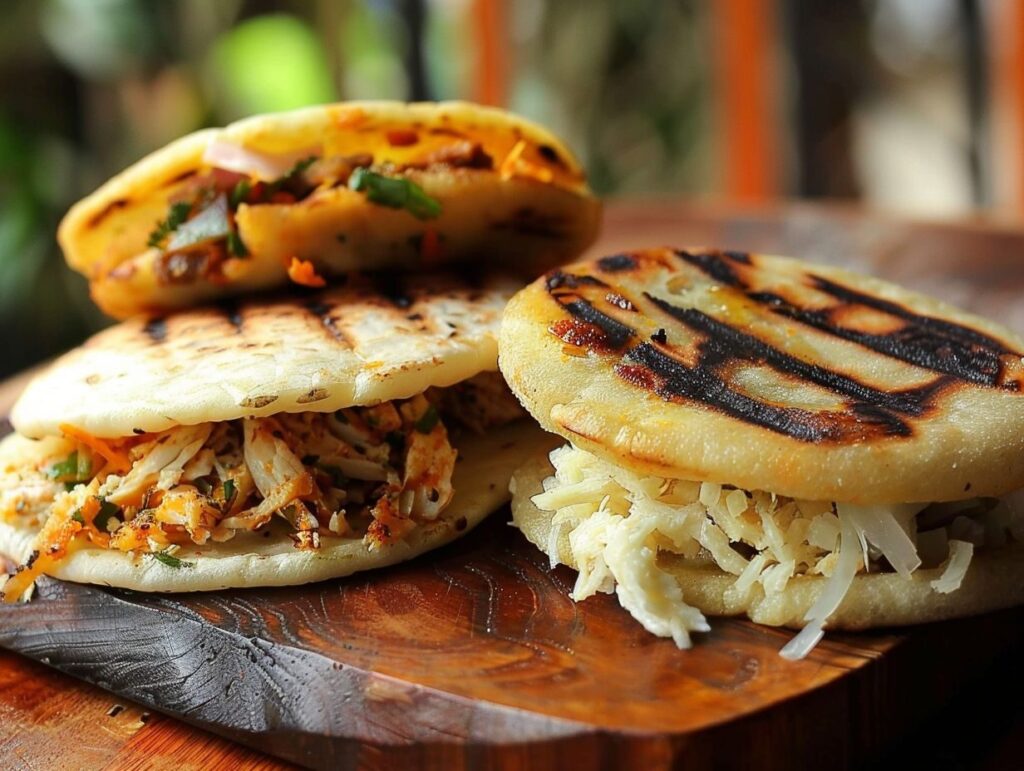Key Takeaways:
- Pupusas and Arepas are popular Latin American dishes made with different types of corn dough and filled with various ingredients.
- Pupusas originated from El Salvador while Arepas originated from Colombia and Venezuela.
- Pupusas are thicker and have a chewier texture, while Arepas are thinner and have a crispier texture.
What are Pupusas?
You’ve got to try pupusas – they’re a traditional dish from El Salvador that’ll make your taste buds dance! Picture this: thick handmade corn tortillas filled with all sorts of yummy ingredients and cooked to perfection.
The history of pupusas goes way back to the indigenous Pipil tribes in what’s now El Salvador.
Nowadays, these savory delights are a big part of Salvadoran culture, showing up at family get-togethers, festivals, and street food stalls.
Regarding fillings, you’ve got options like revueltas (cheese, beans, and pork mix), queso con loroco (cheese with loroco flower), and chicharrón (seasoned pork).
Bite into a pupusa, and you’ll experience a crispy outside with a gooey, soft inside that’s just heavenly.
The flavors are rich and comforting, making pupusas a fave pick for both locals and visitors.
What are the Ingredients of Pupusas?
When making pupusas, you gotta have the key ingredients on hand: maize or corn flour, cheese, and beans.
Mix ’em all up, and you’ve got yourself a delicious and savory filling for those corn tortillas.
To keep that classic pupusa taste alive, these ingredients are a must-have.
Depending on where you are, different regions might mix things up with fillings like loroco (an edible flower bud), pork, or a medley of cheeses.
But, at the end of the day, cheese and beans are the OGs that give pupusas their authentic flavor.
The melty cheese and creamy beans are what bring those rich, comforting flavors that make pupusas a star in Salvadoran cuisine.
How are Pupusas Prepared?
When you make pupusas, you start by shaping the corn dough into a disc and then filling it with your favorite ingredients like cheese or beans.
Then, you cook up the stuffed corn patty on a griddle until it’s nice and crispy on the outside while staying gooey on the inside.
After mixing the corn dough with water and salt to get that perfect texture, you divide it into small portions and flatten them gently into discs.
The yummy fillings, whether it’s savory refried beans or melty cheese, get placed in the middle of these flattened rounds and carefully sealed by folding the dough over them.
Next, you press the pupusas gently to make sure the filling is evenly spread out and they’re the same thickness all around.
Then, it’s time to cook them on a griddle until they turn a beautiful golden-brown color, giving you that ideal mix of crispiness and tenderness. Delicious, right?
What are Arepas?
If you’ve never tried them, you’re missing out! Arepas are a favorite food in Colombia and Venezuela, made from masa harina, a type of corn flour, and they’re loved for their versatility and delicious taste.
The magic of masa harina is key here – it’s what gives arepas their unique texture and flavor that people can’t get enough of.
Making arepas is pretty straightforward.
You mix masa harina with water, and sometimes throw in a pinch of salt or butter for extra flavor, to make a dough.
Shape that dough into patties, then cook them on a griddle or pan until they get a crispy crust on the outside but stay soft and fluffy inside.
The end result? A scrumptious snack or meal that hits the spot any time of day. Trust me, you’ll want to give them a try!
What are the Ingredients of Arepas?
The primary ingredients in arepas are masa harina, water, and salt.
You mix them together to form a dough, shape it into patties, and cook them up to make those delicious flatbreads.
Masa harina, which is finely ground maize, is what gives arepas their unique flavor and texture.
There are all kinds of variations of arepas depending on the region.
In Colombia, they stuff them with cheese, while in Venezuela, they prefer them plain or with different fillings.
What’s great about arepas is their simplicity – you can fill and top them with just about anything.
Whether you’re having them for breakfast, lunch, or dinner, arepas are a popular dish in many Latin American households.
How are Arepas Prepared?
When making arepas, you start by mixing masa harina with water and salt to create a dough.
You then shape that dough into patties and cook them on a griddle until they’re crispy on the outside and soft on the inside, bursting with flavor.
The key to nailing the perfect arepa is getting the dough just right – not too dry, not too wet.
Once you’ve got that down, you can play around with fillings like shredded beef, avocado, or even cheese.
Arepas are super versatile and are loved in many Latin American countries because they can be topped with both traditional and out-of-the-box ingredients.
Whether you’re into savory or sweet, arepas have got you covered with a variety of flavors to suit different tastes and preferences.
Differences Between Pupusas and Arepas

Regarding Latin American cuisine, you’ve got pupusas and arepas, both popular corn-based dishes that offer unique culinary experiences with their own origins, ingredients, preparation methods, textures, and flavors.
Pupusas hail from El Salvador, where they’re a national treasure.
These babies are typically made with maize flour, water, and stuffed with goodies like cheese, beans, or meats.
You shape the dough into a thick tortilla-like form, cook it on a griddle, and end up with a crispy outside and a gooey, cheesy inside.
Now, arepas are the Venezuelan and Colombian stars of the show.
They’re made with pre-cooked cornmeal or maize flour, molded into thick patties, and either grilled, baked, or fried.
Arepas have a dense texture and a hint of sweetness from the corn, giving them a whole different vibe from the softer, more flexible pupusas.
Origin
You should know that pupusas have their origins in El Salvador, where the indigenous Pipil tribe first whipped them up.
Arepas, on the other hand, hail from Colombia and Venezuela, particularly favored by the Timoto-Cuica people.
It’s cool how these corn-based foods reflect the diverse cultural heritage of their respective regions.
The history of pupusas and arepas is closely tied to the traditional cooking methods and eating habits of the indigenous communities living in these areas.
For the Pipil tribe in El Salvador, pupusas weren’t just a basic meal—they carried deep cultural meanings, often playing a role in various ceremonies and rituals that connected food to their identity.
Similarly, the Timoto-Cuica folks in Colombia and Venezuela saw arepas as more than just food; they were symbols of their heritage and ancestral customs, shaping the culinary traditions of these countries over many generations. Fascinating stuff, right?
Ingredients
When you’re talking about pupusas, you’re looking at a mix of corn flour stuffed with tasty fillings like cheese and beans.
On the other hand, arepas take masa harina, water, and salt, transforming it into a griddled corn patty with its own unique flavor profile.
The corn flour in pupusas gives them a dense, slightly chewy texture that’s just perfect for locking in all those delicious fillings.
When you sink your teeth into one, you get an explosion of flavors. In contrast, arepas made with masa harina have a softer, crumblier texture that makes sure the filling is evenly spread throughout the patty.
These differences in texture really shape how each dish feels in your mouth and the overall taste experience.
It’s what makes them favorites for food lovers all over the globe!
Preparation Method
When you’re talking about pupusas and arepas, you’re diving into the world of delicious handheld treats.
Pupusas are like little corn tortillas that are stuffed and cooked on a hot griddle.
Arepas, on the other hand, are discs of dough cooked on a griddle, showing off different techniques for making these famous foods.
Getting that perfect shape is key when making pupusas or arepas. For pupusas, you shape the dough into a small disk, fill it up with tasty stuff like cheese, beans, or meats, and seal it tight before grilling.
Arepas go through a similar shaping process, where you shape the dough into a thick patty that cooks up nice.
The texture and thickness of the dough really make a difference in how these dishes turn out – crispy on the outside, soft and doughy inside, giving them that special yum factor.
Texture and Flavor
You know how pupusas are all about those diverse flavor profiles influenced by different regional tastes, right? They’ve got that dense, chewy texture that’s just perfect with their hearty, savory flavor profile.
On the flip side, arepas are all about that crispy crunch on the outside and that soft, fluffy inside.
It’s like a party in your mouth with those different textures, giving you the perfect base for all kinds of fillings and toppings.
This whole texture and flavor showdown between pupusas and arepas really shows off the amazing culinary diversity of Latin American cuisine.
Pupusas, loaded up with stuff like cheese, beans, or pork, give you this rich, satisfying experience with every single bite.
And those arepas, crispy on the outside and soft on the inside, are just begging for a filling of cheeses, meats, avocados—you name it.
It’s all about how regional ingredients and cooking styles come together to create these unique taste experiences in these go-to dishes for Latinx communities.
Which is More Popular: Pupusas or Arepas?

Regarding pupusas and arepas, both dishes carry a lot of cultural weight in their countries.
Pupusas are a big deal in El Salvador, almost like a national treasure, while arepas are warmly embraced in Venezuela and Colombia, showing off the distinct culinary traditions and tastes of these South American lands.
In El Salvador, pupusas aren’t just a meal; they’re a direct link to the country’s past and sense of self.
Whether it’s the classic corn dough stuffed with cheese, beans, or pork, or the tangy curtido and tomato salsa on the side, pupusas are a full-on celebration of El Salvador’s delicious flavors and heritage.
And over in Venezuela and Colombia, arepas mean more than just a quick bite – they’re a cozy hug and a sense of togetherness.
Whether they’re loaded with tasty fillings like shredded beef or topped with cheese and avocado, arepas bring folks closer, all while honoring their shared cultural backgrounds.
What are the Similarities Between Pupusas and Arepas?
If you’re in South America, you’ve got to try both pupusas and arepas – they’re like the cool kids of quick snacks, offering up tasty options whether you’re in the mood for a light bite or a full-on meal.
These corn-based treats are all about being flexible and easy to enjoy.
What’s cool about these popular snacks is that you can stuff them with pretty much anything you want – whether it’s savory meats, gooey cheeses, or tasty veggies and beans.
Pupusas, hailing from El Salvador, usually come with curtido, a zesty cabbage slaw, while arepas, the Colombian and Venezuelan favorites, can be topped with things like shredded beef, avocado, or cheese.
They’re the ultimate go-to comfort foods for festivals, family get-togethers, and street food adventures, bringing people together through tasty traditions in South American culinary scenes.
How are Pupusas and Arepas Served?
You’ll often find pupusas and arepas on the table, topped with delicious toppings like Curtido, a tangy cabbage slaw, making them a go-to choice for breakfast, lunch, or dinner in many Latin American households.
For breakfast, fill them up with savory stuff like cheese, beans, or meats for a hearty kickstart to your day.
They’ll also hit the spot for lunch, serving as a satisfying meal alongside a side salad or protein.
And for dinner, pupusas and arepas can take center stage, with toppings like salsa or avocado.
These dishes hold a special place in the culture, uniting families and communities over daily meals and sharing in those beloved flavors.
What are Some Common Toppings for Pupusas and Arepas?
Common toppings for pupusas and arepas include Curtido, a tangy cabbage slaw, as well as various salsas, cheeses, and meats.
These toppings add layers of flavor and texture to these beloved corn-based dishes, enhancing your taste experience.
Curtido, with its zesty vinegar kick, helps cut through the richness of the stuffed corn cakes, giving you a refreshing contrast.
Salsas, from mild to fiery-hot, bring bursts of flavor, while cheeses offer a creamy richness.
Meats like shredded pork or chicken add savory notes, giving you that satisfying protein boost.
You can get creative with unique combinations, like spicy chorizo with creamy avocado or tangy feta cheese with roasted vegetables.
These innovative flavor profiles will take your dining experience to a whole new level.
Which is Healthier: Pupusas or Arepas?
When you’re looking for tasty and nutritious options, both pupusas and arepas have got your back.
Pupusas bring the protein and fiber punch with ingredients like beans and cheese, while arepas step up as a gluten-free choice for those with dietary restrictions.
These Latin American delights are all about keeping it wholesome.
Not only do pupusas and arepas bring the nutrition, but they’re also super versatile.
If you’re a veggie lover, customize your pupusas with veggies and beans.
And for those steering clear of gluten, arepas can be made with alternative flours like cornmeal.
Pair these goodies with nutrient-packed sides like salads or grilled veggies to level up the health factor.
Adding pupusas and arepas to your meal plan is a surefire way to keep things balanced and delicious.
What are Some Health Benefits of Pupusas and Arepas?
Pupusas and arepas offer you some great health benefits.
They’re gluten-free, which is awesome if you have any dietary sensitivities.
Plus, they’re packed with essential nutrients like protein, fiber, and carbs that are key for a balanced diet.
If you have celiac disease or just can’t handle gluten, pupusas and arepas are your go-to meals.
They’re full of important vitamins and minerals like iron, magnesium, and zinc, which keep your body running smoothly and support your overall health.
Adding pupusas and arepas to your diet not only boosts your nutrient intake but also adds some variety to your meals and fits perfectly with your specific dietary needs.
Can Pupusas and Arepas Be Made Gluten-Free?

You can easily whip up gluten-free pupusas and arepas by using instant corn masa flour, which doesn’t have any gluten in it.
It’s a tasty and safe option for folks with gluten sensitivities or celiac disease.
This handy gluten-free flour not only keeps the authentic flavors and textures of pupusas and arepas intact but also simplifies the whole cooking process.
To make these delectable dishes without gluten, just mix instant corn masa flour with water and a bit of salt until it forms a flexible dough.
Then, stuff the dough with your preferred fillings like cheese, beans, or meats, shape them into discs, and grill or fry them to a beautiful golden brown.
The end result? A delightful gluten-free snack that everyone can savor!
How are Gluten-Free Versions of Pupusas and Arepas Made?
When you make gluten-free versions of pupusas and arepas, you use instant corn masa flour that has undergone nixtamalization.
This process involves soaking corn in an alkaline solution like lime, softening the kernels, and boosting their nutritional value.
The end result is a safe and tasty gluten-free option for those with dietary restrictions.
During nixtamalization, the corn kernels go through a chemical change that breaks down the hulls and enhances the maize’s nutrition.
The lime not only softens the corn but also helps remove the pericarp, making the kernels easier to digest.
By soaking and cooking the corn with lime, then grinding it into masa harina, you create the gluten-free base for pupusas and arepas.
This masa harina is naturally gluten-free and serves as a versatile and delicious foundation for a variety of fillings and toppings in these traditional dishes.
Frequently Asked Questions
What is the difference between pupusa and arepa?
Pupusa and arepa are both traditional, corn-based dishes from Latin America. While they may seem similar, there are some key differences between the two.
Are pupusas and arepas made with the same type of corn?
No, pupusas are made with masa harina, a special corn flour used to make tortillas, while arepas are made with masa de maíz, a coarser corn flour.
How are pupusas and arepas cooked?
Pupusas are cooked on a flat griddle, while arepas are usually cooked on a griddle or in a pan with oil.
What fillings are typically used in pupusas and arepas?
Pupusas are usually filled with cheese, beans, and/or meat, while arepas can be filled with a wide variety of ingredients, including cheese, meat, vegetables, and even eggs.
Which dish is more popular in El Salvador, pupusas or arepas?
Pupusas are the national dish of El Salvador and are extremely popular and widely available in the country. Arepas, on the other hand, are more commonly associated with Colombia and Venezuela.
Can pupusas and arepas be considered similar to tacos and quesadillas?
In some ways, yes. Pupusas and arepas are both corn-based dishes that are filled with various ingredients, similar to how tacos and quesadillas are made with tortillas. However, pupusas and arepas have distinct flavors and textures that set them apart from tacos and quesadillas.
